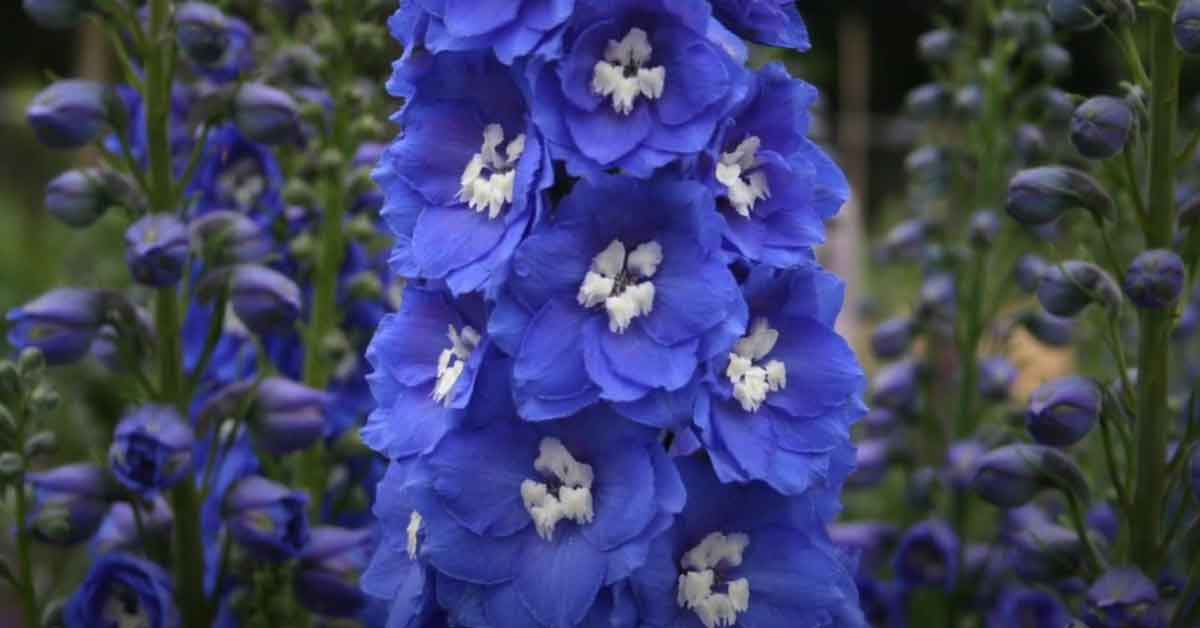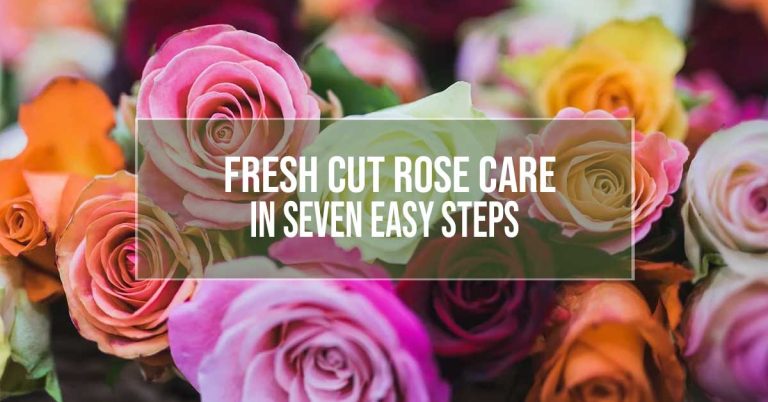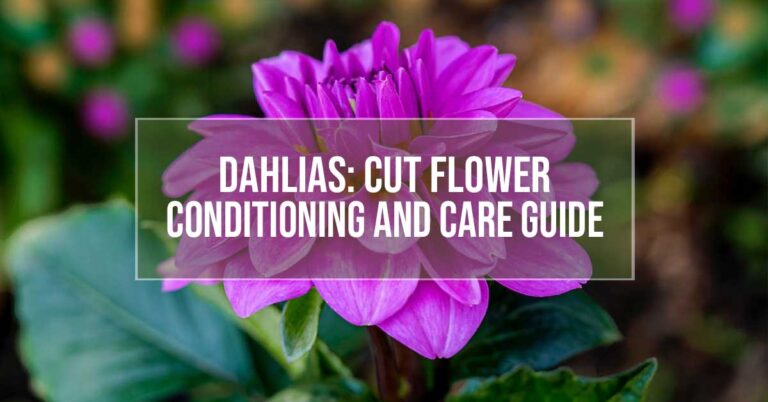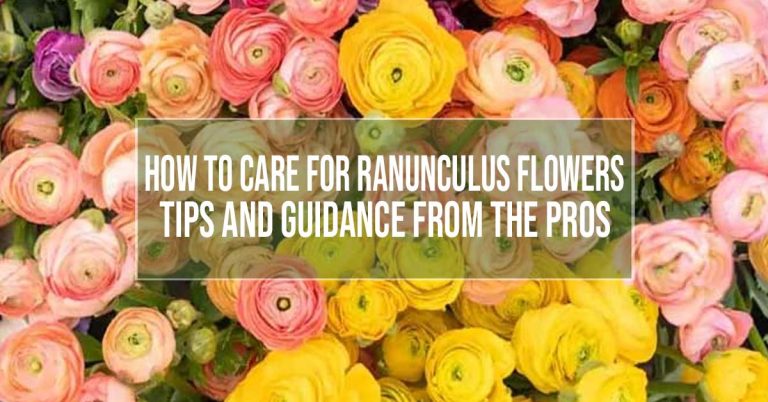There are only a handful of naturally blue flowers. One of the most popular is Delphinium.
While Delphiniums are not the hardiest or longest-lasting flowers, with proper care and handling, they are a beautiful addition to all floral arrangements, from bridal bouquets to majestic vase arrangements.
Delphiniums are part of the Ranunculaceae plant family, which includes Ranunculus, Anemones, and Larkspur (Consolida). The bloom colors range from indigo to purple, sky blue, pink, and white.
Originally native to the northern hemisphere and parts of Africa, delphinium can now be found in gardens worldwide. Primarily thought of as a summer flower (they are the July birth flower), delphinium is available year-round.
Florists like to use cut Delphiniums, combined with other summer filler flowers, to create natural garden-style arrangements, like the summer bouquet we did below.
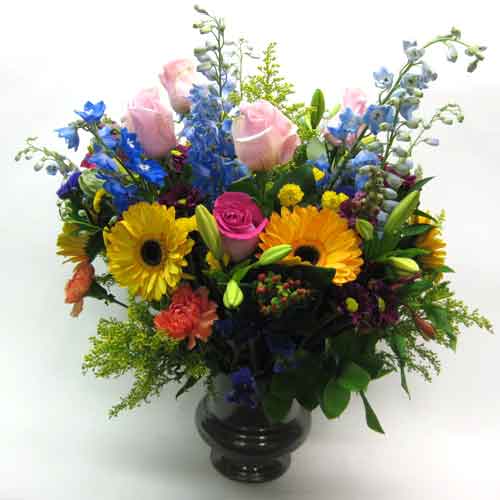
But they can also be as sophisticated as you want them to be. Delphiniums will deliver your desired look, whether you want dark blue drama, soft white whimsy, or a contemporary floral design.
In this article, you will learn everything you need to know about delphinium cut flower care.
Delphinium Varieties and Colors
The following table summarizes some common delphinium varieties and the colors available for each:
| Variety | Colors Available |
|---|---|
| Delphinium Belladonna | Dark Blue, Light Blue, White |
| Delphinium Elatum | Purple, Dark Blue, Lavender, Light Blue, White |
| Delphinium Hybrid | Blue, Dark Blue, Lavender, Light Blue, Peach, Purple, White |
| Delphinium Sea Waltz | Dark Blue |
| Delphinium Sky Waltz | Light Blue |
| Delphinium Volkerfrieden | Dark Blue |
| Delphinium Waltz | Dark Blue, Light Blue |
The delphinium varieties have some key differences:
- Delphinium Belladonna is known for their dainty, slender spikes and loosely arranged florets. They have an airy, delicate look, much like wildflowers, and can be used in different floral designs, from everyday arrangements to wedding bouquets.
- Delphinium Elatum has dense, pyramidal flower spikes on tall (36 – 60 inches), sturdy stems. The florets are densely packed, making them a great choice for large, statement floral designs.
- Delphinium Hybrids exhibit qualities from both Belladonna and Elatum types. They combine the grace of the Belladonna with the boldness of Elatum. The flower spikes are medium to tall (24 – 60 inches, depending on the type). The florets are full but not overly dense.
- The Waltz and Volkerfrieden varieties are hybrids bred for uniform bloom size and flower color, like deep blue or light blue. They are my favorites for most types of floral work
In a nutshell, the Belladonna types are delicate-looking, Elatum has bolder, densely-packed flower spikes, and the Hybrids strike a balance between the two while offering more color options.
The specially bred hybrids, like Waltz and Volkerfrieden, offer uniform stems and flower colors.

Choosing Delphinium: What To Look For
When buying Delphinium, there are a few things to keep in mind.
First, remember that the flowers on the spikes open from the bottom up. Look for bunches with two or three lower flowers opened and some closed flower buds at the top.
Delphinium is extremely ethylene-sensitive, much more so than most other flowers. It’s one of the reasons you don’t often see them sold in supermarket floral departments unless they can be safely stored away from other produce.
Most commercial flower growers who supply retail and wholesale florists treat delphinium with an ethylene action inhibitor, but others may not.
While it’s not something you should obsess over, if you notice any stems with shattered flowers, avoid purchasing them. Shattered flowers are a sign of ethylene exposure or that the flowers have been stored too long.
Basic Delphinium Care: How To Condition And Care For Cut Delphinium
When your delphinium arrives, start by filling a bucket with clean water and commercial fresh flower food, mixed according to directions. I suggest using plastic buckets and avoiding metal or galvanized ones if possible.
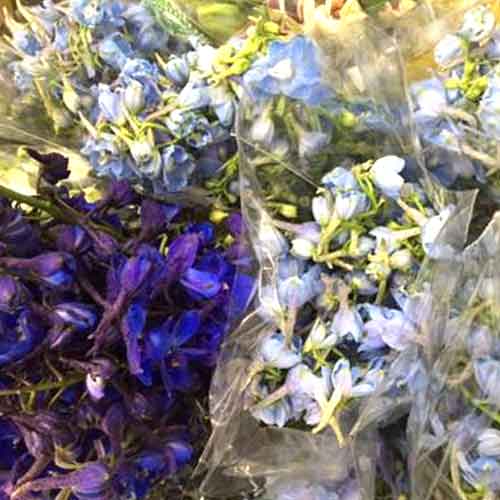
When unpacking Delphinium, gently separate the stems to prevent damage. Cut about 1” off the stems using a clean, sanitized floral knife or clippers, and treat with FloraLife® Quick Dip to allow for maximum water uptake before placing the stems into your bucket.
Also, be sure to remove all foliage below the water level.
Allow at least 2 hours for delphiniums to hydrate. We usually give them 3 to 4 hours in our shop before using them.
Delphiniums love cool temps (35-40°F) and high humidity. But if you don’t have a commercial flower cooler, keep your delphinium in the coolest space possible and out of direct sunlight.
The average vase life of delphinium ranges between 4 and 12 days, so chances are that if you use them for an event and purchase them from a reputable floral source, they will hold up just fine for the duration of the event.
Recut the stems and change the water daily to ensure the longest vase life. Add commercial floral food to the water as directed. This is important to inhibit ethylene effects.
Designing With Delphimium
Delphinium stems can be used in all types of floral design work, including everyday arrangements, sympathy, wedding, and special event work. Individual florets can be used in wedding bouquets, corsages, boutonnieres, and other wearable floral designs.
One caveat: Do not use delphinium as a garnish or to decorate any edible food items, like a wedding cake, for example, as they can be toxic. According to the ASPCA, delphinium may be toxic to some pets as well
Final Thoughts
So why not enjoy the beauty of delphiniums? Despite their delicate nature, with proper Delphinium care and handling, their dramatic flower spikes will help you create stunning bouquets and show-stopping floral arrangements in color palettes ranging from dramatic dark blues to delicate whites.
Following these practical Delphinium care tips ensures your gorgeous cut flowers maintain their beauty and make your event one to remember.
Want More Cut Flower Care Tips Like This?
Enter your email address, and I’ll let you know whenever I post new tips.
We will only use your information to send you our blog updates. You can change your mind anytime by clicking the unsubscribe link at the bottom of any email you receive from us. You can find details about our privacy practices here.
You can also follow me on social media for updates. And if you enjoyed what you just read, share it with your friends.
Til next time,


